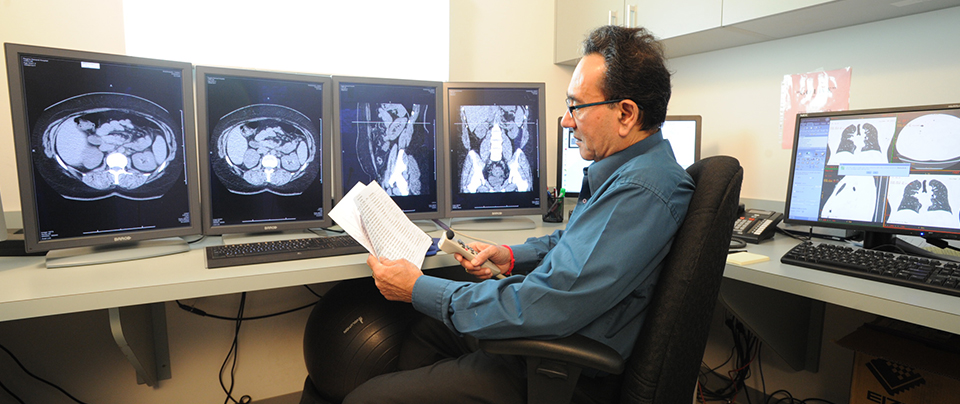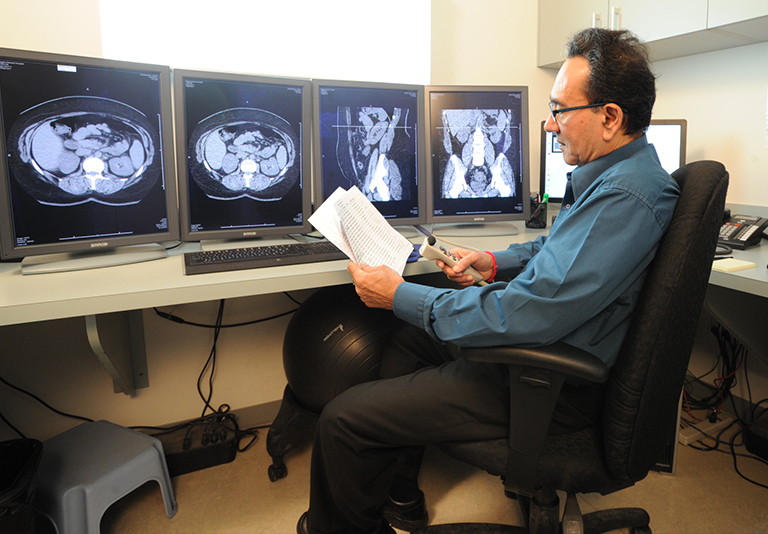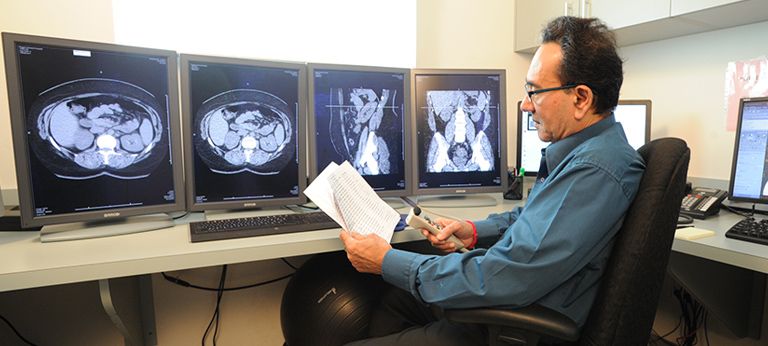We provide community-based CT services under contract with the Regina Qu’Appelle Health Region. When you are referred to the Health Region, you may be advised that your examination will take place at Prairie Skies Medical Imaging, Parliament Avenue location.
CT scanning is useful when detailed 3-D images of certain parts of the body, like soft tissues, the pelvis, blood vessels, the lungs, the brain, abdomen and bones are needed.
The CT Scanner emits narrow X-ray beams through the body to produce a 3-D image of what is happening inside. It is the preferred method of diagnosing and monitoring many cancers, such as liver, lung and pancreatic. A scan of the head can provide the doctor with important information about the brain - he/she may want to know whether there is any bleeding, swelling of the arteries (aneurysms) or tumors. A CT scan can also tell the doctor whether the patient has a tumor in his/her abdomen, and whether any internal organs in that area are swollen or inflamed. It will reveal whether there are lacerations of the spleen, kidneys or liver and can reveal vital data about injuries to a patient’s skeletal structure.
Benefits
- CT scanning is rapid, painless, noninvasive and accurate.
- It can image bone, soft tissue and blood vessels all at the same time.
- Provides very detailed images of many types of tissue as well as the lungs, bones, and blood vessels.
- CT examinations are fast and simple; in emergency cases, they can reveal internal injuries and bleeding quickly to help save lives.
- CT has been shown to be a cost-effective imaging tool for a wide range of medical problems.
- CT is much less sensitive to patient movement than MRI.
- CT can be performed if you have an implanted medical device of any kind, unlike MRI (e.g. pacemakers).
- CT imaging is a great tool for guiding minimally invasive procedures such as needle biopsies and needle aspirations of many areas of the body, particularly the lungs, abdomen, pelvis and bones.
- A diagnosis determined by CT scanning may eliminate the need for exploratory surgery and surgical biopsy.
- No radiation remains in a patient's body after a CT examination.
- X-rays used in CT scans have no immediate side effects.
Risks
- During the examination some radiation is emitted in order to acquire the image. The Prairie Skies Medical Imaging CT scanner has modern software that allows the images to be collected using less radiation than standard CT scanners. A recent dose survey of our scanner showed that, depending on the type of exam, it uses less than half the radiation dose of the Saskatchewan average and less dose than established North American and European Guidelines.
- The benefit of an accurate diagnosis generally outweighs any potential risk.
- Women will be asked about the possibility of pregnancy and they should always inform their doctor and X-ray or CT technologist if there is any possibility that they are pregnant.
- CT scanning is safe but in general, not recommended for pregnant women unless medically necessary.
- Nursing mothers who are concerned about contrast material in the breast milk could wait for 24 hours after contrast material injection before resuming breast-feeding.
- The risk of serious allergic reaction to contrast materials that contain iodine is rare, and radiology departments are well equipped to deal with them. Patients will be asked to sign a form to consent prior to being given contrast media.
- Because children are more sensitive to radiation, they should have a CT study only if it is essential for making a diagnosis and should not have repeated CT studies unless absolutely necessary.
Preparing for the procedure
Doctors may ask the patient to fast (eat nothing) and even refrain from consuming liquids for a specific period before the scan.
Some patients may be given a contrast dye which is injected in an arm vein. This improves visualization of blood vessels and the body organs. Patients will be asked about their allergy status and should report accurately, especially any history with contrast materials. There are some medications that reduce allergic reactions to contrast materials.




